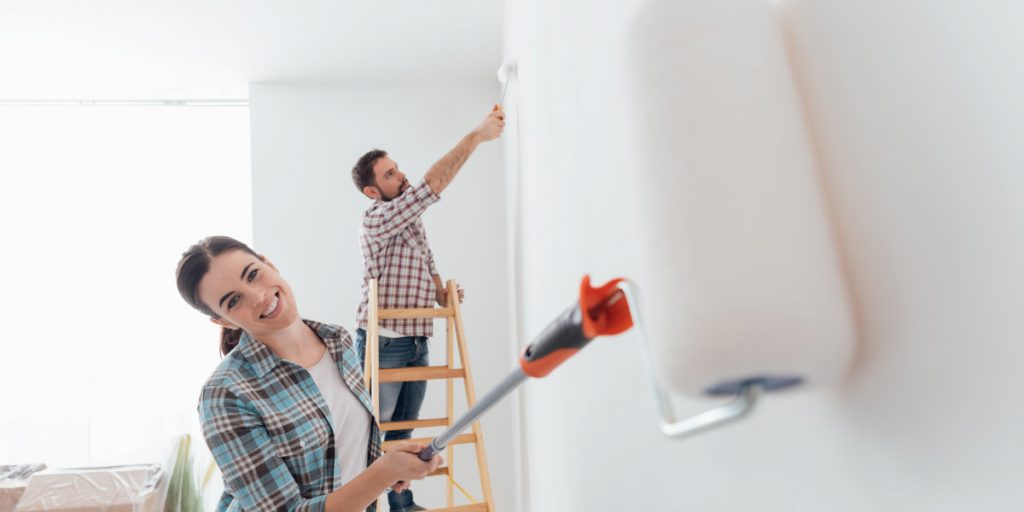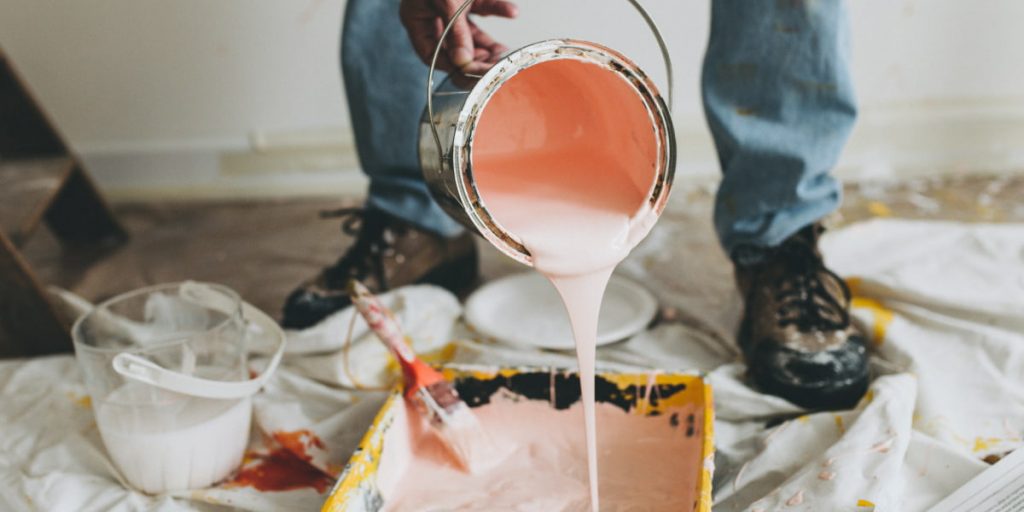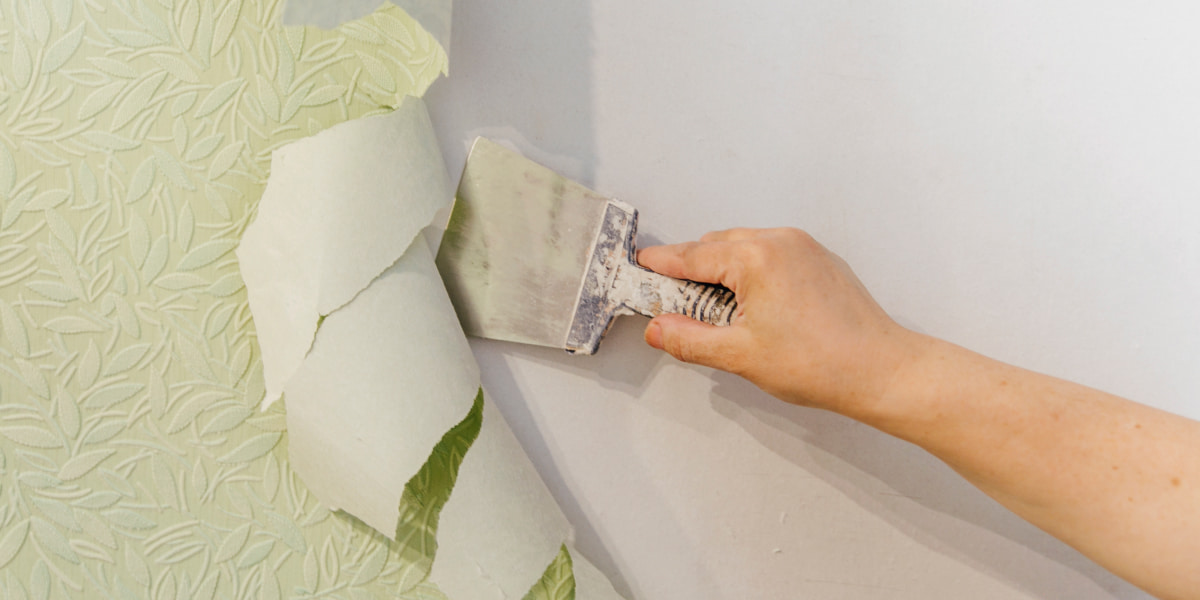Published on November 29th, 2022
Last updated on February 3rd, 2023
How To Paint On Wallpaper With No Issues

Wallpapering and painting with your own hands is not very difficult. This finishing technology can learn almost every person. But first, you must decide what wallpaper and paint to use.
If you like to change the interior frequently, a great solution would be to finish the walls with wallpaper underpainting. You can paint any room, for example, the kitchen. All you have to do is buy some paint and spend a day or two on the job to make the room look new. And you have a completely updated room ready to go. Construction material stores offer a vast assortment of different kinds of wallpaper now. There is a unique wallpapering for painting.
In this article, we will talk about the types of this type of wallpaper. How to match them with paint, detailing the repair process, and giving some tips on how do you paint over wallpaper.
Which Wallpapering Is Good for Painting?

Renovate the interior of the apartment and spend a minimum of effort. You can paint the room in a new fashionable color. Let’s find out what wallpaper you can paint.
- Paper wallpaper is the most inexpensive and traditional type of wall covering. They come in one-layer and two-layer (duplex). Duplex looks strong enough and sometimes has an interesting embossed texture. However, even if they are two-layer, conventional paper products may not survive the color change.
- Vinyl wallpaper has a paper base. It is more durable and moisture-resistant than paper. It is advisable to paint foam vinyl primarily for vinyl wallpaper. It means that the strength of the material, in any case, will allow you to apply paint to them. But will the silkscreen print afterward become more beautiful?
- There are two types of fleece options: on a fleece backing with a vinyl foam top layer and fully fleece backing. The rolls of the material are very strong and resistant to mechanical stress. Due to its strength, you can repaint this material in different colors five to ten times.
What Materials Should Be Chosen for Painting Wallpaper?

Paintings for wallpaper are an essential parameter when wallpapering, which will either get a perfect finish or spoil the interior in the future. You should use qualitative the chosen paint composition. As the finished room will look more original and compelling. So, what paints can you use for painting wallpaper:
- It is worth choosing latex or acrylic paints for rooms with a high level of humidity. They perfectly tolerate moisture or mechanical action;
- Latex paints are also suitable for sunny rooms. Because these compositions do not burn out under constant exposure to ultraviolet light;
- Matt paints are perfect for finishing walls and ceilings with defects. Also, the design will go for large-sized rooms or spacious halls;
- In some cases, you can use glossy paints to highlight an embossed pattern. You can do it on a smooth background with a matte finish. So, it will be easy to understand how to paint on wallpaper with this type of paint;
- Acrylic paints are speedy drying and easy to apply;
- Satin paint is also suitable for the kitchen or bathroom. The material shows high wear resistance and durability;
- You can paint fleece wallpaper only with water-based paint.
For each wallpapering, it is necessary to use a different type of painting composition
- Paper: Water-based (glossy or matte).
- Fleece: Water-based paint.
- Glass wallpaper: Latex or acrylic.
How Do You Paint Properly Over Wallpaper?

Before you paint over wallpaper, it is necessary to prepare the surface properly. The walls must be:
- dry;
- flat, as far as possible, in the room’s conditions;
- clean.
You can produce a surface treatment. Depending on the kind of your old wallpapering for painting. Usually, you plaster brick walls and only putty concrete walls. You apply putty in two layers and will apply the second after drying the first. The wall is first impregnated with primer. Finally, you threaten the surface with sandpaper. After which, you can glue wallpaper.
To carry out the work, prepare the tools you will need to paint any wallpaper qualitatively:
- narrow brushes or short rollers to create a precise contour;
- roller with a long pile for embossed wallpaper and with a short pile or paralon for smooth wallpaper
- containers for diluting the paint;
- masking tape to prevent any paint from getting into places that do not need to be painted.
The quality of the roller affects the quality of wallpapering painting no less than the paint itself. We recommend using a roller with an elongated pile. It will ensure good penetration of the bottom pattern of the wallpaper. To apply paint to the corners, use narrow brushes or short rollers. Before you paint the wallpaper, cover the floors, radiators, and window sills with tape. Baseboards and eaves can be covered with paper tape. Which is removed before the wallpaper paint dries.
When you have prepared everything with wallpapering, you can begin painting. Here is a detailed description of the sequence of steps:
- Pour the paint into the recess of the cuvette so that it fills it but does not cover the embossed surface.
- Dip a brush, remove the excess and work it along the ceiling and in hard-to-reach areas.
- Dip the roller into the paint and roll it several times in the relief to remove the excess. If too much paint is used, it can leave a smudge and spill paint all over the place.
- Start from top to bottom. Paint evenly over the areas. Then you need to move it consistently in the same direction, for example, only vertically.
- The paint is always applied in 2 layers, so do not try. Thoroughly paint every relief recess. Your task is to apply a layer without any visible gaps.
Do not interrupt the work to paint evenly. Masters recommend you turn off your phone. Because you will get distracted until the process is complete.
- You need to let the coating dry once you have painted the walls. You can find the drying time in the paint’s instructions, but it usually takes at least an hour. To prevent the roller from drying out, wrap it with plastic wrap.
- Start painting the wallpapering for the second time, moving in the same sequence as the first.
- Remove spatters and drips while the paint is fresh. Be sure to rinse and dry your tools when finished.
Bottom Line
Paintable wallpaper is a great way to be creative and feel like an interior designer. Now you know how to paint on wallpaper. Painted wallpaper is good at absorbing sound, creating comfort in the room, and protecting the walls from damage. Even if something doesn’t work out, you can always redo it. Experiment to make your home truly distinctive and unique.
FAQ
How can I repaint wallpaper?
You can change the color of the coating at any time as long as the previous layer is dry. To change a darker color to a lighter one, use a trick: cover the wallpaper with a layer of white paint first, then move on to the colored one. Otherwise, you’ll have to apply three to five light coats to eliminate the dark shade.
What is the best paint for painting the wallpapering in the kitchen?
Latex or acrylic paint is the right solution for kitchens and bathrooms. They are resistant to moisture and steam. Also, water-dispersion composition is suitable, as it is not afraid of water and cleaning.
What is the best roller to paint with?
It is better to use a paint roller for anyone who plans to paint wallpaper by hand. Specifically, a long-necked roller. The lint can penetrate the texture’s depth, painting the most inaccessible places.
How to paint on wallpaper correctly?
You should properly glue the wallpaper on the surface of the walls or ceiling. The overlap is performed only at the joint. After that, you should choose the necessary paint, which has an acrylic base and carries information about the permission to apply it to the fleece surface.


